|
|
March 2025
| Sun |
Mon |
Tue |
Wed |
Thu |
Fri |
Sat |
|
|
|
|
|
|
1 |
| 2 |
3 |
4 |
5 |
6 |
7 |
8 |
| 9 |
10 |
11 |
12 |
13 |
14 |
15 |
| 16 |
17 |
18 |
19 |
20 |
21 |
22 |
| 23 |
24 |
25 |
26 |
27 |
28 |
29 |
| 30 |
31 |
|
|
|
|
|
|
  

|
健全な精神は,健全な肉体に宿る。 その逆も真なりと
考えています。
脳力の退化するスビ-ドを幾分なりとも減速するために,
私は週1 回,近くの英会話教室に通って脳トレをしています。
高校生,大学生,会社員,主婦の若い女性の皆さんに
囲まれたサロン的な雰囲気で,その中から生気も吸収して
います。
つたない英語力ですが,教室で話した内容等々について
Weekly Topics としてご紹介します。
こんな風に表現した方が良いとか,よりネィティブな
表現があれば,是非ともお気軽にBBSを利用して教えて
下さい。
宜しくお願いします。
A sound mind in a sound body.
I believe that the opposite is also true.
I go to the English conversation class nereby once a week in order
to slow down the degeneration of my brain just a little.
The classroom is like a place for social interaction,and I get
inspired with vigor of the young participants including high
school and university students,office workers and houswives.
In this page,I would like to share with you what I discuss about
in the class as a weekly topic.
Please feel free to give me a comment through BBS on my
expression of writing in English such as "The better way to write
in English is ----.".
Thank you very much.
|
Walking around Fushimi, Kyoto and Fushimi Taiko
Bar Hopping(2/2_Fushimi Taiko Bar Hopping) No.311-Feb.23,2025
|
My walking around Fushimi, which also included a histrical walk, came
to an end, and
it was just time for lunch.
So I headed out for today's main event, “Fushimi Taiko Bar Hopping”.
At this event, we can choose 4 stores of our choice from the 52 participating
stores and
enjoy bar hopping at them.
When paying, we will hand over one of a set of 4 bar tickets we purchased
to the shop as
payment.
However, if we order additional drinks or food, we will need to pay separately.
[Note] head out for ~ ; ~に出かける、 ~ of one's choice ; 自分の好みの~、自分で選んだ~
bar hopping ; ハシゴ酒、 hand over ~ ; ~を手渡す、 purchase ; 購入する、 payment ; 代金
Today is the final day of the two-day event, and the middle day of a three-day
weekend,
so the streets of Fushimi are bustling with event participants.
Here again, I leave the Bar Map open.
Pls click on the square in the upper right corner of the MAP to enlarge
it
|
| Fushimi Histrical Walking and Bar Hopping Route Map |
[Note] a three-day weekend ; 週末の3連休、 bustling with ~ ; ~で賑わっている
participant ; 参加者、 leave ~ open ; ~を開けておく、を開けたままにしておく
I headed to the izakaya “Torisei Honten”(Bar② on the BAR MAP) that serves
delicious
yakitori.
It is one of the participating shops in the Bar event near the former site
of Aizu clan garrison
(Fushimi Mido) which was the final destination on my histrical walk.
This is because I had a social drinking party here with my cousin and my younger brother
and his wife on October 25, 2023.
The photos below are nostalgic ones at that time.
|
|
|
Nostalgic photos of a social gathering with my cousin and my younger brother
and his wife at Torisei Honten (2023/10/25) |
[Note] former site of Aizu clan garrison ; 会津藩駐屯地跡、 nostalgic ; 懐かしい
However, the Torisei Honten was so crowded with event participants waiting
in line
that there was no room to step.
First of all, I checked in at the numbered ticket issuing machine, but
there were 50 other groups
ahead of me, and I had to wait 70 minutes.
The wait was so long that I went to another bar, but it was the same situation
there.
Of course, I put my name on the waiting list at both izakaya.
|
|
| Gekkeikan “Miyakoshikomi Kyosansui” |
After about 25 minutes, I was able to enter a Japanese izakaya
called “Kyoto's Kitchen・Tsuki no Kuraudo” (bar① on the BAR
MAP), which is located near Torisei Honten.
This is a Gekkeikan brand izakaya that was renovated from the
Gekkeikan sake brewery in Fushimi.
The bar set menu consisted of yuba and beef tendon oden for food,
and Gekkeikan's sake, “Miyakoshikomi Kyosansui” for drinks.
One small glass of sake wasn't enough, so I ordered another.
I was hungry, so the alcohol really seeped into my stomach.
|
|
|
Japanese izakaya “Kyoto's Kitchen・Tsuki no
Kuraudo” (2025/02/23_12:57) |
Sake and nibblies from the bar menu
(2025/02/23_13:20)
|
[Note] wait in line ; 順番待ちする (in line ; 一列になって、並んで)
there is no place to step ; 足の踏み場もない、 numbered ticket issusing machine
; 整理券発券機
put one's name on a waiting list ; (人の)名前を順番待ちリストに載せる、 renovate ; 改装(改修)する
beef tendon ; 牛すじ、 Miyakoshikomi Kyosansui ; 都仕込み 京山水、
seep into ~ ; ~に沁みる、 nibblies ; (酒の)おつまみ
The second place is Torisei Honten, which was crowded earlier.
Luckily, I only had to wait for two other groups, so I was able to enter
right away.
This was also a yakitori restaurant that had been renovated from a sake
brewery.
|
|
|
| Chicken dishes “Torisei Honten” (2025/02/23_13:41) |
The bar set menu consisted of three kind s of their proud yakitori, smoked
duck, and jellyfish with plum flavor for food, and Shinsei's unpasteurized
sake delivered directly from the brewery or beer by
the glass for drink.
As you ca see in the photo, the restaurant was full of people
attending the event.
I enjoyed a sip of Shinsei's unpasteurized sake for my drink.
|
|
|
| Torisei Honten with fully occupied seats |
First, a small glass of sake with some nibblies
(2025/02/23_13:48) |
[Note] only have to do ~ ; ~しさえすればよい、 ~するだけでよい、 smoked duck ; 合鴨の燻製
jellyfish with plum flavor ; 梅で味付けしたクラゲ、 beer by the glass ; グラスビール
unpasteurized zake ; (低温殺菌されていない)生原酒、 Brewery-fresh ; 蔵出し、蔵元直送の
a sip of ~ ; 一口の~
Torisei Honten has a strong spirit of service.
After a while, three kinds of freshly grilled yakitori were served nibblies.
I checked the menu and had another small glass of brewery-fresh raw sake.
This raw sake is rich and full-bodied, and goes perfectly with yakitori.Full-bodied
The yakitori here is the best!
|
|
|
| Shinsei brand sake menu |
Anoter glass of sake with 3 kinds of
yakitori as nibblies (2025/02/23_14:28) |
[Note] freshly grilleg ; 焼きたての、 full-bodied ; コクのある、 go with ~ ; ~とよく合う、調和する
Now, I'm thinking about where to go for the third place.
I decided to head to Ryoma Street , where there are rows of restaurants.
On this street, there was a restaurant with a large lantern hanging from
it that
said “Teppan Kushiyaki”.
There is also a Fushimi Bar event flag hanging there.
This is the teppan skewered grill izakaya “Sakura” that serves grilled skewers
and creative cuisine.
I decided to go in here as I didn't have to wait in line.
|
|
|
Teppan skewered grill izakaya “Sakura”
(2025/02/23_14:22) |
Fushimi Taiko set menu served at “Sakura”
(2025/02/23_14:28) |
[Note] be rows of ~ ; ~が軒を連ねる、 lantern ; 提灯、 teppan skewered grill ; 鉄板串焼き料理
skewered ; 串刺しした、 grilled skewer : 串焼き、 wait in line ; 並んで待つ
|
|
| Kitagawa Honke's honjozo sake “Tomiou” |
Since I was alone, I was shown to an empty counter seat.
Drinks on the bar menu were draft beer, highball, or sake.
Here too, I chose sake.
This izakaya serves several types of Fushimi brand sake, but the
one served as the bar eventi was Kitagawa Honke's honjozo sake
“Tomiou”.
Food is homemade roast beef and Isobe-style namul made with
cream cheese.
This nibblies also went well with Japanese sake and was delicious.
Of course, needless to say, I had another small glass of sake here too.
Well, my Bar Hopping is finally coming to an end.
I've already had six glasses of sake, including refills, and so I feel
good.
I searched for bars near Chushojima Station on the BAR MAP and found the
perfect
izakaya.
It is “Okobu Kitase”(bar④ on the BAR MAP), run by a long-established kelp
shop
The Bar Menu on the leaflet states that the food will be kelp kasu soup
and drink will be
Japanese sake from Fushimi.
|
|
| Dashi (broth) bar Kitase serving creative kelp dishes and Japanese sake
(2025/02/23_15:05) |
[Note] show someone to a seat ; ; (人)を席に案内する、Isobe-style namul ; 磯部風ナムル
needless to say ; 言うまでもなく( needless ; 不必要な )、 refill ; (飲食物の)お代わり
long-established ; 老舗の、長い歴史のある、 kelp ; 昆布
kelp kasu soup (kelp kasu-jiru) ; おこぶの粕汁
It was crowded, but there were a few empty seats at the counter so I sat
there.
What was served was not sake from Fushimi, but “Tarekuchi-sake”, a raw
sake from Joyo
Sake Brewery in Yamashiro,Kyoto.
|
|
|
Newly brewed sake “Tarekuchi”, a raw sake from
Joyo Sake Brewery (2025/02/23_15:11) |
Kelp kasu soup (2025/02/23_15:14) |
Well, my mouth was dry so the kasu-jiru was delicious.
The newly brewed sake “Tarekuch” was also fragrant, mellow and delicious.
I enjoyed the Fushimi Taiko Bar Hopping Event about four-hours, including
a histrical
stroll through Fushimi.
The only time I've ever gone bar hopping was when I was still active, so
this is the first
time in 20 years.
It may be because I'm heaithy and love sake that I'm able to go bar hopping despite my
age.
I have to be grateful that I am able to come all the way to Fushimi to
drink.
Wow, today I wandered around bars just as much as Yoshida Rui!
Muttering to myself like that, I left the town of Fushimi feeling a little
tipsy.
|
|
| Streetscape of Fushimi・Chushojima shopping district (2025/02/23_15:37) |
[Note] Tarekuchi-sake ; たれ口酒、 newly brewed sake ; 新酒、 fragrant ; 香りの高い
mellow ; まろやかな、 despite one's age ; 年甲斐もなく、年齢にもかかわらず、 grateful ; 感謝する
come all the way ; はるばる(わざわざ)やって来る、 wander around ~ ; ~をさまよい歩く、歩き回る
as much as ~ ; ~と全く同じだけの、 Yoshida Rui ; 吉田 類 (酒場詩人、居酒屋探訪家
mutter to oneself ; 独りつぶやく、 tipsy ; ほろ酔いの、 streetscape ; 街並みの風景
【End】
The other day, I read an article with the headline “Bar-hopping at great
price in Fushimi,
the town of sake breweries” in the local edition of the newspaper.
It seemed like an interisting event, so I decided to attend for the first
time.
I visited the Fushimi Tourist Association website right away and booked
my ticket online.
To my surprise, there was only one ticket before they sold out, but I managed
to make a
reservation just in time.
The event will be held on both February 22nd(Sat.) and 23rd(Sun.), but
the only day left
I can attend is the 23rd.
[Note] headline ; 見出し, bar-hopping ; 飲み歩き、 at a great price ; お得な価格で
sake brewery ; 酒蔵、Fushimi Tourist Association ; 伏見観光協会
There is only one ~ left ; ~は一つしか残つていない、 manage to ~ ; 何とか~する
just in time ; ギリギリ間に合って
The Fushimi Taiko Bar event was canceled a few years ago due to the effects
of
COVID-19, but it seemed to be a popular event that has been held since
2012.
52 restaurants from Fushimi Otesuji Shopping Street and Keihan Chusyojima
area
(Fushimi Momoyama area) will participate and offer special value food and
drink
set menues exclusive to the bar event.
[Note] Fushimi Otesuji Shopping Street ; 伏見大手筋商店街, special value ; 特別価格、お得な
Keihan Chusyojima ; 京阪中書島、 exclusive to ~ ; ~だけに限定されている
The Fushimi area is blessed with abundant water and has been a thriving sake brewing
area since long ago.
During the Azuchi-Momoyama period, it flourished as a castle town of Fushimi
Castle, and
during the Edo period, it flourished as a port town where 10-koku ships
traveled between
the town and Osaka.
Iit was also the historical stage toward the end of Tokugawa Shogunate,
and many historical
sites remain, including Teradaya, which is associated with Ryoma Sakamoto.
[Note] be blessed with ~ ;~ に恵まれている、 thriving ; (産業などが)繁栄している、盛んな
since long ago ; 昔(ずっと以前)から、 flourish ; 繁栄する、 10-koku ship ; 十石船
toward the end of Tokugawa Shogunate ; 幕末期に、 be associated with ~ ; ~と関係がある
I took advantage of this opportunity to enjoy a bar-hopping while taking
a historical stroll.
Below is the leaflet for this event.
[Note] take advantage of A to ~ ; Aを利用して~する
This is a bar map of Fushimi, Kyoto.
When I woke up this morning, I was very surprised to see a thin layer
of snow, as you
can see in the photo below.
The weather forecast said it would be cloudy with occational sunny spells,
so I decided
to attend the event.
I took the Kintetsu Line from Kyoto Station, changed to the Keihan Line
at Tambabashi
Station, and arrived at Chushojima Station just after 11 o'clock.
|
|
|
This morning's weather (View of Mt. Hiei
from my house) (2025/02/23_08:16) |
Keihan Line Chushojima Station North Exit
(2025/02/23_11:12) |
Using Bar Map as a reference, I started my historical walk around Fushimi
from
Chushojima Station.
The walking route is as shown in the Google Map below.
[Note] a thin layer of snow ; 薄っすらと積もった雪
cloudy with occational sunny spells ; 曇り時々晴れ (occasional ; 時々、 sunny spells
; 晴れ間)
use ~ as a reference : ~ を参考にする
Route map for Fushimi Historical Walk and Bar Hopping Festival (Fushimi
Taiko Bar) |
The first place I visited was Chokenji Temple, which belongs to the Daigo school of
Shingon Buddhism and was founded in the early Edo period.
The vermilion mountain gate facing the Horikawa River, which was the outer
moat of
Fushimi Castle is eye-catching.
If you walk straight through the gate, you will see the main hall in front
of you.
The principal image is the only Benzaiten (Sarasvati) in Kyoto.
|
|
|
The mountain gate(Ryugumon Gate) of
Chokenji Temple (2025/2/23_11:17) |
The view of the main hall |
Thereis a temizuya (purification fountain) on the left side in front of
the main hall.
This is Aka-sui, one of the famous springs of Fushimi,Kyoto.
|
|
| Aka-sui in the grounds of Chokenji Temple |
[Note] Daigo scool of Shingon Buddhism ; 真言宗醍醐派、 vermilion ; 朱色の
outer moat ; 外堀、 eye-catching ; 人目を引く、目立つ、 principal image ; 本尊
Benzaiten (Sarasvati) ; 弁財天、 fountain ; 泉、噴水
By chance, I met a monk who seemed to be the head priest in the temple
grounds, who
gave me a detailed explanation about Aka-sui.
Originally, this water was offered to Buddha.
There are several underflow water sources from Lake Biwa in Kyoto,and.one
of them is
said to be located underground in Fushimi.
The place name Fushimi seems to come from the word “fusimizu” which means
underflow
water.
[Note] by chance ; たまたま、偶然、 head priest ; 住職、 Aka-sui ; 閼伽水
underflow water ; 伏流水、 fusimizu ; 伏水(ふしみず)
I walked along Horikawa River, crossed Fushimi Minato Park, and came out
onto Takeda
Kaido.
There was a stone monument marking the site of the Fushimi Choshu Clan
Residence on
the west side of this Kaido, just after crossing the intersection with
the trafic lights.
This place has now been transformed into the Fushimi Civil Engineering
Office.
[Note] Takeda Kaido ; 竹田街道、site of the Fushimi Choshu Clan Residence ; 伏見長州藩邸跡
be transformed into ~ ; ~に変わる(変身する)、 Civil Engineeering Office ; 土木事務所、
|
|
|
Stone monument at the site of the
Choshu Clan Residence in Fushimi
(2025/2/23_11:36) |
Explanation of the stone monument |
The information board next to the monument reads:
In the early hours of July 19,1864, during the late Edo period, Choshu
clan Karo Fukuhara
Echigo led about 500 armed soldiers from the Choshu clan residence in Fushimi
and
marched to Kyoto.
Along th way, they clashed with soldiers from the Ogaki, Aizu, Kuwana,
and Sabae
domains who were guarding the Takeda Kaido near Inari on the Fushimi Kaido,
and
the Kinmon Rebellion broke out.
The Choshu clan soldiers led by Fukuhara retreated and returned to his
Fushimi clan
residence.
They fought back after reorganizing, but the allied forces including the
Hikone clan
bombarded the clan residence from Kyobashi, causing it to burn down.
In other words, the Fushimi Choshu clan residence was one of the sites
of the Kinmon
Rebellion at the end of Edo period.
[Note] fukuhara Echigo ; 福原越後、 karo (chief retainer) ; 家老、 retainer ; 家臣、家来
in early hours ; 未明に、 choshu clan residence ; 長州藩邸
the late Edo period /the end of Edo period / the last days of the Tokugawa
Shogunate ; 幕末
along the way ; その道中(途中)で、 clash with ~ ; ~と衝突(会戦)する
Kinmon Rebellion ; 禁門の変 【Rebellion ; (政府に対する暴力を使った)反乱、謀反 】
break out ; 急に起こる、勃発する、 retreat ; 退却する、撤退する、 allied forces ; 連合軍
fight back ; 応戦(反撃)する、 reorganize ; 再編成する、 bombard ; 砲撃する、爆撃する
burn down ; 燃え落ちる、全焼する、
Walking about 80 meters north along Takeda Kaido, You canl find the remains
of the
“30-koku boat pier” at the foot of Kyobashi Bridge over Horikawa River.
|
|
The remains of the “30-koku boat pier” at the foot of Kyobashi Bridge
over Horikawa River (2025/02/23_11:48) |
The Horikawa River (tributary of Uji River) was built in 1594 to transport
construction
materials for Toyotomi Hideyoshi's construction of Fushimi Castle.
During the Edo period, wholesalers, inns, sake breweries were built along
the Horikawa
River, and the area became a loading wharf known as Fushimihama, where
small boats
transporting rice, firewood, charcoal, brewed sake, and other goods passed
through.
In particular, the area around Kyobashi was bustling with over a thousand
boats
transporting goods, including the 30-koku boata heading down the Yodo River
to Osaka,
the Yodo 20-koku boats heading to Yamashiro, and Shiba boats heading to
Uji.
It seems to have been the center of Fushihama.
Currently, it seems that tourist boats such as 10-koku boats and 30-koku
boats are in
operation.
|
|
|
The view of the east side of Horikawa River
from Kyobashi Bridge (2025/02/23 11:46) |
The view of the west side of Horikawa River
from the foot of Kyobashi Bridge
(2025/02/23 11:49) |
[Note] 30-koku boat pie ; 三十石船の桟橋、 remain ; 跡、遺構、 tributary ; 支川、派流
Fushimihama ; 伏見浜、 firewood ; まき、charcoal ; 木炭、 pass through ; 通行(通過)する
bustle with ~ ; ~で賑わう、 Yodo 20-koku boat ; 淀二十石船、 shiba boat ; 芝舟
On the north side of Kyobashi Bridge there is a stone monument marking
the site of
the fierce battle at Fushimiguchi.
On the evening of January 2, 1868, the day before the Battle of Toba-Fushimi
began, about
200 vanguard troops traveled by boats from Osaka and landed at Kyobashi
in Fushimi.
They fought here, using Fushimi-Mido as their camp.
The Shogunate forces and Shinsengumi, who had set camp at the Fushimi
Magistrate's
Office, retreated towards Yodo, setting fire to private homes, and so many houses in the area
were burned down and suffered extensive damage.
[Note] fierce battle ; 激戦、 the Battle of Toba-Fushimi ; 鳥羽伏見の戦い
vanguard troops ; 先鋒隊 (vanguard ; 先陣、先駆けtroops ;部隊、軍勢)、 camp ; 野営地
Shogunate forces ; 幕府軍、 Shinsengumi ; 新撰組、 Fushimi Magistrate's Office
; 伏見奉行所
retreat ; (軍隊などが)退却する、撤退する、 set fire to ~ ; ~に火を放つ、~に放火する
suffer damage ; 被害(損害)を受ける
The Battle of Toba-Fushimi was the first armed conflict between the new
Meiji
government and the former Shogunate forces.
This was the first battle of what is now known as the Boshin War.
This occurred shortly after the Edo Shogunate was abolished by “the Restoration
of
Imperial Rule” and “the Great Call for the Restoration of Monarchy” (both
in 1867) and
the new Meiji government was established.
The Satsuma and Choshu clans, which led the movement to overthrow the
shogunate,
fought on the side of the new government.
The former Shogunate forces included the former Shogunate Army, the Aizu
and Kuwana
clans, and the Shinsengumi.
The commander of the former Shogunate forces was Tokugawa Yoshinobu , the
last
Shogun of the Edo Shogunate.
However, Keiki himself remained in Osaka Castle due to poor health and
did not participate
in the battle.
[Note] armed conflict ; 武力衝突、 Boshin War ; 戊辰戦争
the Restoration of Imperial Rule ; 大政奉還(日本の幕末の)王政復古、 abolish ; 廃止する
the Great Call for the Restoration of Monarchy ; 王政復古の大号令
overthrow ; 転覆させる、打倒する、 commander ; 大将、司令官、
Stone monument at the site of ↑
the fierce battle of Fushimiguchi
Explanation of the above monument →
|
|
After passing this fierce battlefield, I turned right and walked about
100m to get to the
historical site,“Teradaya”.
This is the main site on today'shistorical walk.
I've always wanted to visit this place so I was happy to be able to do
so.
Teradaya was a port inn in Fushimi.
It is known as the stage of the “Teradaya Incident” at the end of the
Edo period.
It was damaged during the Battle of Toba-Fushimi in 1868, but was later
rebuilt.
The following two incidents, which occured at Teradaya, an inn at the end
of the Edo
period, are kown as the Teradaya Incidents.
1.The incident that occured in 1862, when the Satsuma Domain suppressed
the
pro-imperial patriots.
2.The attack on Sakamoto Ryoma by the Fushimi Magistrate that occured
in 1866
|
|
|
| The reconstructed Teradaya today (2025/02/23 11:53) |
Teradaya Histric Site (2025/02/23 11:54) |
[Note] port inn ; 船宿、 Teradaya Incident ; 寺田屋事件、 Satsuma Domain ; 薩摩藩
suppress ; 鎮圧する、抑える、 pro-imperial ; 尊皇派の、 patriot ; 愛国者
After this, I stopped by the headquarters of the Fushimi Taiko Bar venue
to pick up
my reserved ticket.
I paid 3,700 yen for the advance ticket.
Upon entering the Kizakura Memorial Hall from the back entrance, there were videos and
panels on display introducing zake brewing.
|
|
|
|
| Exibit on sake rice |
Exibit on types of sake |
Kizakura Kappa Country Banner
|
[Note] Fushimi Taiko Bar venue ; 伏見太閤バル会場、 advance ticket ; 前売り券
Kizakura Memorial Hall ; 黄桜記念館、 back entrance ; 裏口、 ske brewing ; 酒造り、酒造
on display ; 展示された、 exbit on ~ ; ~に関する展示
Within Kizakura Memorial Hall was Fushim's famous spring water, “Fushimizu.”
Unfortunately, the underflow water “Fushimizu” did not spring up.
This area is blessed with an abundance of underflow water containing the
right amount of
minerals, making it ideal for sake brewing, and many sake breweries are
located here.
I'm sure Kizakura Co.,Ltd. is one of them.
|
|
| The famous spring water “Fushimizu” within Kizakura Memorial Hall (2025/02/23
12:30) |
[Note] Fushimizu ; 伏水、 spring up ; 湧き出る、
make ~ ideal for ・・・・; (主語によって)~が・・・に最適なものになる、 I'm sure ; ~でしょうね
I head to the stone monument at the site of the former Tosa clan residence
in Fushimi.
I looked for the monument at the corresponding spot on the MAP, but couldn't
find it.
Next, I head to the final destination of today's historical walk, the former
site of Aizu clan
garrison (Fushimi Mido).
|
|
Explanation of the stone monument
at the former site of the Aizu clan garrison |
The former site of Aizu clan garrison (Fushimi Mido)
(2025/02/23_12:44) |
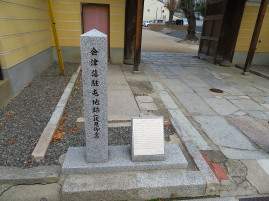
The stone monument at the former site of
the garrison (2025/02/23 12:43) |
|
[Note] corresponding spot ; 該当(対応)する場所
former site of Aizu clan garrison ; 会津藩駐屯地跡
According to the stone monument, Fushimi Mido was founded by Kyonyo, the
12th head
priest of Higashi Honganji Temple, during the Momoyama period.
The grounds for this temple were donated by Tokugawa Ieyasu.
On the evening of January 2, 1868, the day before the Battle of Toba-Fushimi
began, about
200 vanguard troops from Aizu clan landed at Kyobashi in Fushimi and set
up camp at
Fushimi Mido.
At around 4:00 p.m. on the following day, January 3, during a skirmish
with the Satsuma clan,
the sound of a cannon coming from the Toba area was heard.
Cannons from the Satsuma clan stationed on high ground to the east of the
Gokonomiya
Shrine fierd, attacking the Fushimi Magistrate's Office, and so the battle
also began in the
town of Fushimi.
It is said that there was a gunfight using the tatami mats in the main
hall as shilds, and
that the building suffered extensive damage.
Currently, the building has been demolished due to deterioration, and only
the large ginkgo
tree, the bell tower, and the mountain gate remain.
[Note] Kyonyo ; 教如、 donate ; 寄付する、 vanguard troops ; 先鋒隊 (troops ; <軍事>部隊)
skirmish ; (軍事)小競り合い、小戦闘、 cannon ; 大砲、 station ; 配備(配置)する
Gokonomiya Shrine ; 御香宮、 gunfight ; 銃撃戦、 shield ; 盾、防御物、 demolish ; 取り崩す
deterioration ; 劣化、老朽化、 ginkgo ; イチョウ、 bell tower ; 鐘楼
It was a historical walk of about 1 hour and 30 minutes.
I was glad to be able to visit several historical sites while thinking
about Fushimi, a historical
stage plagued by civil war in the late Edo period.
Now, I'm off to today's main event, the Fushimi Taiki Bar Hopping.
I feel a little embarassed about drinking alcohol in the middle of the
day, but since it's a
festival, I think it's okay.
Well then, I'm off.!
[Note] plagued by ~; ~に悩まされた、~に苦しめられた、 be off to ~ ; ~に出かける
feel embarrassed ; 恥ずかしい(きまりが悪い)と思う、 in the middle of the day ; 真っ昼間に(から)
well then ; それでは、 I'm off! ; 行ってきます
To be continued Wtopics-2.311 / “Walking around Fushimi, Kyoto and Fushimi Taiko Wtopics-2.311 / “Walking around Fushimi, Kyoto and Fushimi Taiko
Bar Hopping (2/2_Fushimi Bar Hopping)” (Coming soon. Don't miss
it)
Japanese diary-2.1212 / 「京都伏見街歩き&伏見太閤バル飲み歩き(1/2_伏見街歩き) diary-2.1212 / 「京都伏見街歩き&伏見太閤バル飲み歩き(1/2_伏見街歩き)
Stroll around Osaka Minami(1/2) No.309-Oct.12,2023
-Visiting Namba Yasaka Shrine with its huge object- |
Namba Yasaka Shrine in Osaka was introduced as a spot visited by many
foreign tourists
on the TV program “Why did you come to Japan?” that aired the other day.
This program is a documentary variety show that is aired every Monday
at 6:25 p.m.
on TV Tokyo network.
In the Kansai area, it is aired on TV Osaka.
It's the program I often watch when I have time, as I can enjoy interesting
interviews
conducted directly at the airport about their goals for sightseeing, work,
studying abroad,
etc.
[Note] Namba Yasaka Shrine ; 難波八坂神社、 air ; (ラジオ、テレビなどで)放映する、放映される
documentary variety show ; ドキュメントバラエティー番組、 conduct ; 行う、実施する
The reason they visit Namba yasaka Shrine seems to be that they are interested
in the
huge object “Shishi-den(Lion hall)” on the grounds.
I was curious about the exsistence of such a unique shrine, so out of
curiosity I also
headed out to see it right away.
I thought I would get bored of just visiting here, so I decided to visit
Shitennoji Temple nearby.
[Note] object ; オブジェ、 Shishi-den(Lion Hall) ; 獅子殿、 curious ; (面白そうなので)気になる
out of curiosity ; 好奇心から、興味本位で [curiosity:好奇心]、 head out to ~ ; ~に出かける
get bored of ~ ; ~に飽きる[飽きてしまう]、
|
| Osaka Minami strolling route(Namba Yasaka Shrine⇒Shitennoji Temple) (2023.10.12)
|
From JR Kusatsu Station, I took the special rapid train to JR Osaka Station,
and from
there I took the Osaka Munincipal Subway as shown in the Google map above.
First, I visited Yasaka Shrine near Namba subway Station.
It is a 7-minute walk from Namba Station on the Yotsubashi Subway Line.
Well, I was very surprised!
Along the way, there were many foreign tourists heading to Yasaka Shrine
and returning
after visiting the shrine.
The shrine was located in a bustling downtown lined with large and small
buildings.
I entered the shrine grounds from the entrance with the torii gate on the
west side.
[Note] Osaka Municipal Subway : 大阪市営地下鉄、 along the way ; 途中で
bustling ; 賑わっている、活気のある、 lined with ~ ; ~ずらりと並んだ
shrine grounds ; 神社の境内、 torii gate ; 鳥居
Pls click the picture to see a full-size version
 |
 |
Ground exit of Namba subway station
(2023.10.12_12:06) |
Yasaka Shrine West Entrance
(2023.10.12_12:20) |
As I walked through the shrine grounds, I saw many foreign tourists.
It seems that their purpose was to see the huge object, Shishigashira(Lion's
head) of
Shishi-den(Lion hall) rather than worship at the shrine.
When I walked toward them who were taking pictures, there it was!
A unique giant Shishigashira was scowling menacingly at us with fangs bared!
[Note] shishigashira(Lion's head); 獅子頭、 worship at a shrine ; 参拝する
there it was! ; あった、あった! scowl menacingly at ~ ; ~ をものすごい形相でにらみ付ける
menacingly ; 険悪な表情で、威圧するように、 with fangs bared ; (動物が口を空けて)牙をむきだして
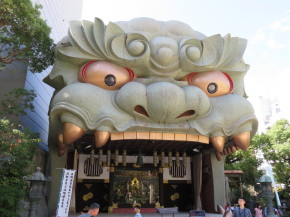 |
 |
Lion head of Shishi-den(Lion hall)
(2023.10.12_12:22) |
Commemorative photo in front of Shishi-den
(2023.10.12_12:22) |
The shrine was damaged in the Great Osaka Air Raid in 1945(Showa 20),
and no
detailed information remains.
However, according to a legend, during the era of Emperor Nintoku(313-399),
an epidemic
occured in thiis area, and Gozu Tenno(Note.1) appeared. So people enshrined the bull's
head.
This is said to be the beginning of this shrine.
(Note.1) Gozu Tenno(牛頭天王) was originally the guardian deity of Gion Shoja in India.
In Japan, it is enshrined at Yasaka Shrine in Gion, Kyoto as a deity that
protects against
epidemics.
[Note] Great Osaka Air Raid ; 大阪大空襲 (raid ; 奇襲、急襲)、 according to a legend ;
according to a legend ; 言い伝えによると、 era of Emperror Nintoku ; 仁徳天皇の時代
Gozu Tenno ; 牛頭天王、 enshrine ; 祭る、安置する、 bull ; 雄牛、 guardian deity ; 守護神
Gion Shoja ; 祇園精舎、 protect against ~ ; ~から身を守る、~を防ぐ
The head shrine of Namba Yasaka Shrine(難波八阪神社) is Yasaka Shrine(八坂神社)
in Kyoto.
It was named after the “saka(阪)” in Osaka(大阪).
The main shrine and Shishi-den were built in 1974(Showa 49).
It is 12 meters high, 11 meters wide and 10 meters deep.
It is believed that Shishi's(lion's) large mouth swallows evil spirits,
and so it is said that
people visit the shrine to pray for luck in game (luck in bussiness), academic development,
passing exams,finding employment,etc.
Perhaps because Shishi-den is instagrammable, it has recently become very
popular
on social media.
[Note] be named after ~ ; ~にちなんで名付けられ(てい)る、 swallow ; 飲み込む
evil spirits ; 悪霊、悪魔、 luck in game ; 勝運、 academic development ; 学業向上
passing exams ; 合格、 finding employment ; 就職、 instagrammable ; インスタ映えする
on social media ; SNS(ソーシャルメディア)上で
Some photos taken inside the shrine grounds.
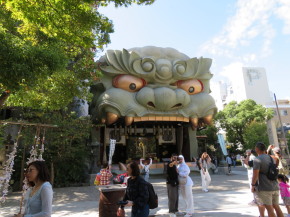 |
 |
In front of Shishi-den crowded with forein tourists
(2023.10.12_12:20 |
Main shrine (2023.10.12_12:21) |
There were three stone trii gates on the south, east, and west sides.
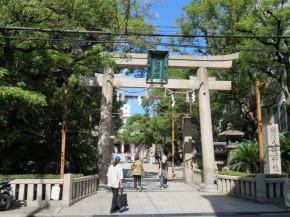 |
 |
| Torii gate on the south side (2023.10.12_12:23) |
Shishi-den seen from the east torii gate side
(2023.10.12_12:29) |
To my surprise, most of the prayers on Ema (the votive tablets) in the
grounds were
written in English, Chinese, etc. by forigners.
(Ema are wooden tablets on which people write their prayers or wishes.)
[Note] prayer ; 祈願、 wish ; 願い事、 Ema : 絵馬、 votive ; 奉納した、願掛けの
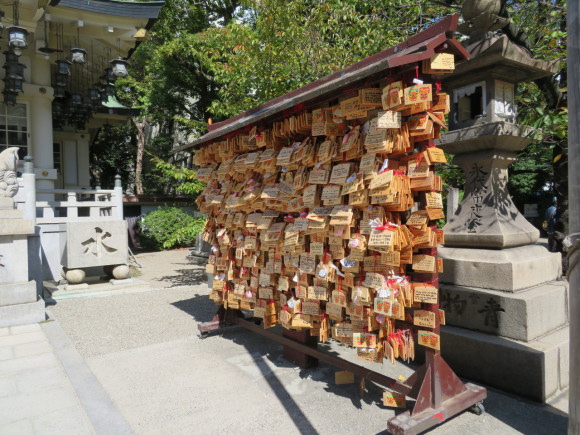 |
| Ema hung in the shrine grounds (2023.10.12_12:29) |
I had never heard of Namba green onion, but now it have been revived as
a traditional
vegetable in Naniwa, and it seems that it originated here.
There are several subsidiary shrines and auxiliary shrines within the grounds.
One of them is Sasayama Shrine.
It was built to honor the legacy of Sasayama Jubei Kageyoshi , an Osaka magistrate who
worked hard to get Namba's vegetable market officially recognized and contributed
to the
development of Namba.
He also assumed the post of Sado Kinzan Magistrate and is said to have
contributed to
the finances of shogunate.
[Note] Nmba green onion ; 難波葱(ネギ)、 subsidiary shrine ; 末社
auxilary shrine ; 摂社、 auxiliary ; 補助(予備、付属)の、 honor ; (公の物や人を)称賛する
honor the legacy ; 遺徳を顕彰する、 Sasayama Jubei kagetoshi ; 篠山十兵衛景義
Osaka magistrate ; 大阪代官 (magistrate ; 判事)
get ~ officially recognized ; ~を公認してもらう、 assume the postof ~ ; ~に就任する
Sado Kinzan Magistrate ; 佐渡金山奉行 (Kinzan=goldmine)
finances ; (政府などの)財源、財政状態
Pls click the picture to see a full-size
version.
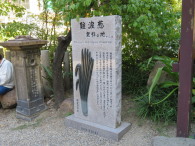 |
 |
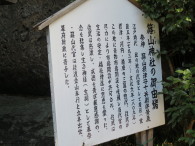 |
Stone monument marking the
birthplace of Namba green onions
(2023.10.12_12:35) |
Sasayama Shrine, a subsidiary shrine of Namba Yasaka Shrine
and a signborad describing its history (2023.10.12_12:36)
|
After visiting the shrine for about 20 minutes, I headed to my next destination,
Shitennoji
Temple.
Japanese Diary-2.1137 / 「大阪ミナミ散策(1/2) Diary-2.1137 / 「大阪ミナミ散策(1/2)
-巨大なオブジェがある難波八阪神社を訪ねる-」
 TOPページへ戻る TOPページへ戻る
|
|